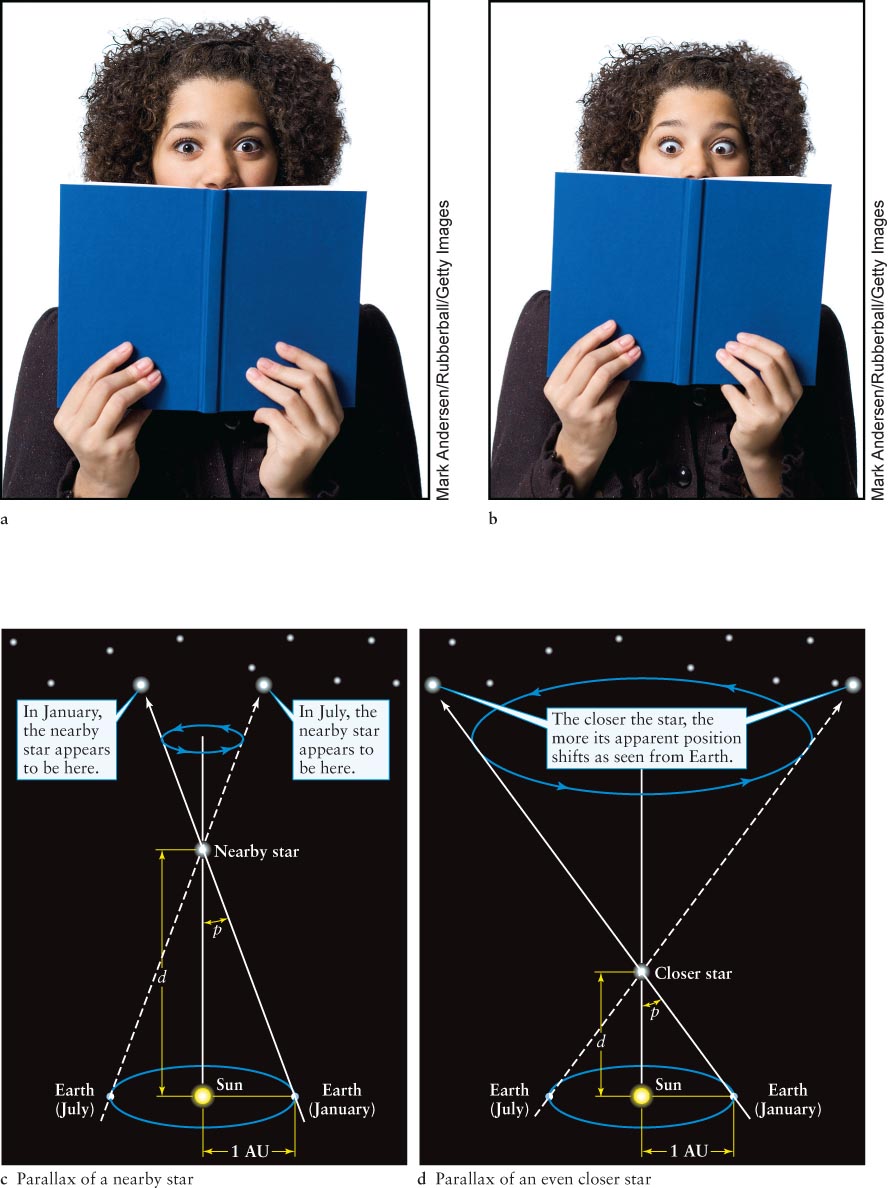LEAVING THE SOLAR SYSTEM
10-1 Distances to nearby stars are found using stellar parallax
Nothing in human experience prepares us for understanding the distances between the stars. On Earth, the greatest distance we read about in our daily lives is perhaps halfway around the globe, 20,000 km (12,400 mi), which is about the distance from New York City to Perth, Australia. By observing the Sun, the Moon, and planets, we have some comprehension of hundreds of thousands, or even millions, of kilometers or miles.
 How far away are the nearest stars outside our solar system? Ask 10 people and you will probably hear answers that range from millions to billions of kilometers or miles. In fact, the closest star other than the Sun, Proxima Centauri, in the constellation Centaurus, is about 40 trillion km (4.0 × 1013 km or 25 trillion mi) away. Light takes more than 4 years to get here from there. Most of the stars you see in the night sky are many times farther away. Given such enormous separations between astronomical bodies, how do we measure the distance to a nearby star?
How far away are the nearest stars outside our solar system? Ask 10 people and you will probably hear answers that range from millions to billions of kilometers or miles. In fact, the closest star other than the Sun, Proxima Centauri, in the constellation Centaurus, is about 40 trillion km (4.0 × 1013 km or 25 trillion mi) away. Light takes more than 4 years to get here from there. Most of the stars you see in the night sky are many times farther away. Given such enormous separations between astronomical bodies, how do we measure the distance to a nearby star?
Because Proxima Centauri is closer to us than other stars, its position among the background stars changes as Earth orbits the Sun. We see precisely the same effect when, for example, Mars appears to have retrograde motion as we pass between it and the Sun (see Figures 2-
Parallax is an everyday phenomenon. We experience it when nearby objects appear to shift their positions against a distant background as we move (review Figure 2-

As Earth moves from one side of its orbit around the Sun to the other, a nearby star’s apparent position shifts among the more distant stars. Referring to Figure 10-
The first stellar parallax measurement was made in 1838 by Friedrich Wilhelm Bessel, a German astronomer and mathematician. He found the parallax angle of the star 61 Cygni to be  , and so its distance is about 3 pc (see Discovery 2-
, and so its distance is about 3 pc (see Discovery 2-
295
Focus Question 10-1
For which object—
296
Telescopes in space are unhampered by our atmosphere and therefore have higher resolutions than Earth-
In 1989, the European Space Agency (ESA) launched a satellite called Hipparcos (an acronym for High Precision Parallax Collecting Satellite and named for Hipparchus, an astronomer in ancient Greece who created an early classification system for stars). Although the satellite failed to achieve its proper orbit, astronomers used it to measure the distances to more than 2.5 million of the nearest stars up to 500 ly (150 pc) away. The success of Hipparcos has led to the 2013 launch of Gaia by the European Space Agency. This satellite will use stellar parallax measurements to determine the distances to the nearest 1 billion stars. In 2014, astronomers succeeded in using the parallax method with the Hubble Space Telescope to accurately measure the distances to a few stars 10,000 ly from Earth.
Despite the information gained from stellar parallax, astronomers need to know the distances to more remote stars for which parallax cannot yet be measured. Several methods of determining ever-
Having established that different stars are at different distances from Earth, we now consider the brightnesses that stars appear to have as seen from our planet. Combining the distances and the varied brightnesses we observe will enable us to calculate how much light stars actually emit and thereby to explore their evolution.